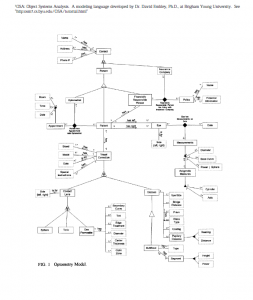Conan C. Albrecht and Dr. Stephen W. Liddle, Accountancy and Information Systems
Many health fields have progressed slowly in the area of computer systems. My research focused on these systems specifically on the optometry health field. Many problems exist with the current systems available to optometrists. This fact is evident by their current use; a survey of ten optometry offices revealed the following distribution:
30% – No computer use–paper and pen
40% – Homespun or franchise-written program
30% – RLI (a popular DOS-based program)
Further research indicated three factors lead to the problem: most optometrists are not trained in the use of computers, the available programs are archaic and hard to use (only a couple are written for Mac or Windows), and current systems do not exploit the power of computers. My research concentrated on the last factor.
Current optometry programs bear a striking resemblance to age-old paper systems. In fact, there are more paper systems converted to computers than computer systems themselves. Consequently, many of the inherent weaknesses of paper systems are still present. Each of the offices I visited also kept paper systems in addition to their computer systems, and they used their computer systems only for billing. They had experienced little increase in efficiency, and in some cases, had created more work for the secretaries.
A computer application founded on the basic objects, events, and relationships involved in optometry needs to be developed. The model in Fig. I uses the OSA technique to analyze the optometry field.’ The model assumes that each person has two eyes (blind or missing eyes are counted as eyes), and includes the sphere and diameter, the attributes of the eye most useful to optometrists. These need to be entered only once for each prescription even though a patient may order glasses, contacts, and other prostheses (other attributes account for differences in prescription due to what is being ordered). The Contact object inherits the attributes of the person and their eyes, so no new information needs to be entered except for those attributes directly related to contacts. The same applies to the Glasses object and its child, the Bifocal object.
The object-based approach presented in this essay has a straightforward interpretation. Each object translates to a real-world object. The attributes and characteristics of objects are found locally on the objects themselves. The model also has a one-to-one relationship with object-oriented programming languages. Object inheritance is easily seen and coded, and object relationships are obvious. The model in Fig. I overcomes the weaknesses of paper systems because it is based on real-world objects and not on paper flow. It offers a solid foundation for an optometry computer system.

